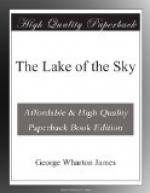Only about five per cent. of the Reserve is barren land, and this is mostly situated at a high elevation above timber line. The tree growth is excellent, and under proper direction reproduction could be made all that any one could desire. Fully twenty per cent., however, of the present Reserve is covered with chaparral. Practically all of this originally was timbered. The chaparral has grown up because nothing was done at the proper time to foster reproduction over acres that had been cut. Systematic and scientific efforts are now being made to remedy this condition, the rangers being encouraged to study the trees, gather seeds from the best of their type, plant and cultivate them. Tree cutting is now so regular as to obtain by natural reproduction a second crop on the logged-over areas. Where natural reproduction fails planting is resorted to. Thus it is hoped, in time, to replant all the logged-over areas now owned by the government, serving the double purpose of conserving the water-supply and providing timber for the needs of the future. Much of the timber-land, however, of the Tahoe region, is patented to private owners. Little, if anything, is being done towards reforestation on these private tracts. Legal enactments, ultimately, may produce effective action along this needed line.
As has elsewhere been shown the world owes a debt of gratitude to the Tahoe region. Had it not been for the timber secured so readily from the Tahoe slopes the mining operations of Virginia City, Gold Hill and Dayton would have been seriously retarded and crippled. As it was the Tahoe trees were transferred as mining-timbers for propping up the immense and continuous excavations of that vast series of honey-combings underground, the products of which revivified the gold supply of the world.
Tahoe timber also has contributed much to the upbuilding of the towns and country farms on the whole upper Pacific Coast and interior regions of Northern California, and today much of its timber finds its way to San Francisco and other Pacific Coast markets.
At Floriston, on the Truckee River, a mill is in successful operation, using Tahoe fir for the making of paper. Red and white fir, which are practically useless for lumber, are found to make excellent wrapping and tissue papers, and thus, from being unremunerative products of our forests, become sources of income. After planing off the bark, the wood is made into small chips, about a half inch square, and an eighth of an inch thick. These chips are then “digested” by a process of mixing with acids and cooking, through which it becomes “wood pulp.” Different processes produce different pulps, two of which are mixed together, allowed to flow out on a very fine wire screen nine feet wide, revolving at a rate of 300 feet a minute, with a “jigging” movement from side to side. This makes all the fibers lie flat. They are then sent through steel rollers, the water squeezed out, and finally carried over and around twenty-five revolving steam-heated cylinders which completely dry the paper and put the needed gloss or finish on it.




